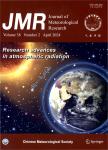Machine Learning-Based Temperature and Wind Forecasts in the Zhangjiakou Competition Zone during the Beijing 2022 Winter Olympic Games
作者机构:China Meteorological Administration Xiong'an Atmospheric Boundary Layer Key LaboratoryXiong'an New Area 071800 Hebei Key Laboratory of Meteorology and Ecological EnvironmentShijiazhuang 050021 Hebei Meteorological ObservatoryShijiazhuang 050021 College of Computer and Cyber SecurityHebei Normal UniversityShijiazhuang 050024
出 版 物:《Journal of Meteorological Research》 (气象学报(英文版))
年 卷 期:2024年第38卷第4期
页 面:664-679页
核心收录:
学科分类:0403[教育学-体育学] 04[教育学] 0706[理学-大气科学]
基 金:Supported by the National Key Research and Development Program of China (2018YDD0300104) Key Research and Development Program of Hebei Province of China (21375404D) After-Action-Review Project of China Meteorological Administration(FPZJ2023-014)
主 题:machine learning ensemble learning post-processing cold air pools mountain Beijing 2022 Winter Olympic Games
摘 要:Weather forecasting for the Zhangjiakou competition zone of the Beijing 2022 Winter Olympic Games is a challenging task due to its complex *** weather prediction models generally perform poorly for cold air pools and winds over complex terrains,due to their low spatiotemporal resolution and limitations in the description of dynamics,thermodynamics,and microphysics in mountainous *** study proposes an ensemble-learning model,named ENSL,for surface temperature and wind forecasts at the venues of the Zhangjiakou competition zone,by integrating five individual models—linear regression,random forest,gradient boosting decision tree,support vector machine,and artificial neural network(ANN),with a ridge regression as meta *** ENSL employs predictors from the high-resolution ECMWF model forecast(ECMWF-HRES) data and topography data,and targets from automatic weather station *** categories of predictors(synoptic-pattern related fields,surface element fields,terrain,and temporal features) are fed into *** results demonstrate that ENSL achieves better performance and generalization than individual *** root-mean-square error(RMSE) for the temperature and wind speed predictions is reduced by 48.2% and 28.5%,respectively,relative to *** the gust speed,the performance of ENSL is consistent with ANN(best individual model) in the whole dataset,whereas ENSL outperforms on extreme gust samples(42.7% compared with 38.7% obtained by ECMWF-HRES in terms of RMSE reduction).Sensitivity analysis of predictors in the four categories shows that ENSL fits their feature importance rankings and physical explanations effectively.



